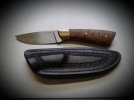In fact for commercial use here in Canada the handles must be sealed to the blade. No cracks and no pins and only stainless steel blades I believe . Some of the carbon Damascus ones makers are completing are very beautiful, such as those made by Salem Straub and many others but I would not try to place them into service in my home. My wife would make sure it would only happen the once. As well, I myself do not feel they are suitable in food use. Yes. that's what they were made for and can do well at but the color change when the the metal does its oxidizing thing- rusting , turns me away. Certainly this is a personal feeling just as I hope I have other personal feelings in all the knives I make. Your arguments on copper and other other bacterial resisting metals just won't pass the Canada inspection thing.
So what you say I have many chefs out there using my Damascus and carbon steel bladed knives. I believe they all can make their own choices. I'm not telling you to stop making them.
On the other hand I believe they sure can be collectibles !!!!
Frank
This baffles me on several points. For one thing, a whole lot of sushi chefs would be pretty ticked at having to use a yanagiba made without e.g. Hitachi blue/white, no traditional tang-burn-in, etc. -- does Dexter or Victorinox make a nice yanagiba with a nice molded nylon handle on 303?

And I'd be surprised if a food inspector would have a problem with a ubiquitous Henckels/Wusthof 3-pin 9". That said: as to carbon being not "suitable in food use" - I think Bob Kramer would be a little surprised by that. I happen to own an
original Kramer 9", with brass + mosaic pins and a nice patina on it. And, while it's also definitely a "collectible" (I've seen 'em go for over $10k on eBay
when you can find one, and a friend of mine has been on his 'lottery' waiting list for 4-5 years now), it works a charm, keeps an edge like a scalpel. And while it patinas, it does
not "rust" - I wipe it dry, and especially after slicing lemons or tomatoes, wipe a little tsubaki (camellia) oil or even just canola before putting it away. It looks like gunmetal, not a shipwreck anchor. Me, I got into knifemaking
because of that knife - I love it, but it's a german-style fatbelly best suited for rock-choppers, and I'm a push-slicer. My previous fave was my grandmother's Sabatier Deux Lions 12" - also high-carbon - about a city-block long with a profile like a Roman spear. I'm making mostly hybrid french/gyutos - in carbon. Bouncing around among 1084, 52100, and 80CrV2 (which actually
does start to spot if you so much as
look at it sideways, but is a dream to work with and then keep sharp), trying to settle on which I like best.
I could not possibly agree more with Salem Straub's points ^^^. Life's full of trade-offs - if you want optimum kitchen steel for actual
cutting, you don't gripe about taking proper care of it. I mean: thoroughbreds are high-maintenance, but boy can they run. But that doesn't mean everybody who wants to ride a horsey should get one.

OTOH (
which still has 5 fingers, crosses-self), I'm with you on "damascus". It's purty, and collectible - great for show. Buys nothing
inherently in performance, though - and it seems a lot of operators sell into the conflation between actual wootz and the historical metallurgical reasons for it -- vs. what's (
usually) just a pretty pattern, and a lot of work and cost. Me, I'll put the aesthetic work into the handle, and the science into the blade.
Sorry for the length; as the man said "I would've made it briefer, but I didn't have time". One last thought: one of the most sublime examples of simple, lasting, popular, and brilliant product design: the Opinel #8. A
fine argument for carbon steel - with a lot of 'votes'.


 IMG_5940
IMG_5940


